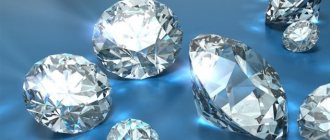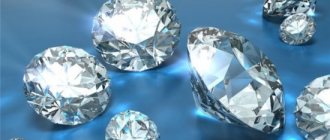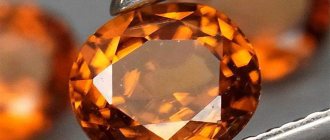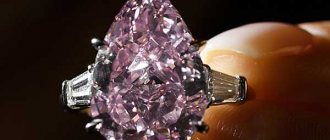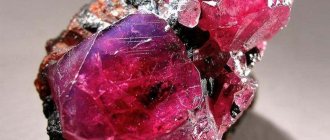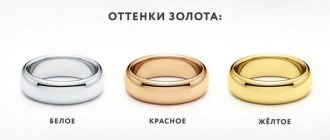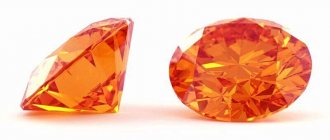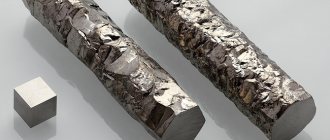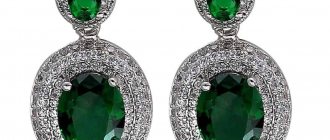Which is better: zircon or cubic zirconia
Zircon, created by nature, is comparable in beauty to precious sapphires and fits organically into any jewelry. Due to the presence of metal impurities in the structure, it has a wide range of colors. Popular varieties:
- jargons – yellow-golden;
- hyacinths - red;
- Starlites are blue.
There are natural specimens in green and black. The crystals of the mineral have a bright shine. This property is successfully used in jewelry to imitate diamonds, chrysolites, and amethysts. Transparent pale blue specimens are especially good. Green zircons contain radioactive substances, the presence of which is determined using a special device.
Synthetic cubic zirconia has become popular due to its extraordinary shine and greater hardness. These qualities bring the mineral closer to diamonds; it looks great in earrings, rings, and necklaces. An artificial gem is not inferior in characteristics to a diamond, and the cost is much lower. After the appearance of cubic zirconia, the demand for products with precious stones dropped significantly.
In choosing: zircon or cubic zirconia, the determining role is played by the appearance, the cost of the product is of great importance.
Natural gem zircon
Zircon is a fairly expensive natural gem. Its cost is comparable to sapphire. In its physical properties and natural beauty it is not inferior to most gems. This transparent stone comes in a variety of colors. It has a strong shine. Previously, in the East, this characteristic was noted separately, referring it to the younger brother of the diamond.
Jewelry with this gem has been known since ancient times. In the Middle Ages, jewelers, not knowing the true physical and chemical nature of zircon, classified it as an imperfect and undeveloped diamond by nature. Noting the significantly lower hardness of the stone and not such a strong shine after cutting. The fact that diamond has nothing to do with zircon and is only a single crystal of the zirconium metal became known much later.
Zircon comes from igneous rocks. Its color is determined by the various chemical elements that are present in it. Jewelers mainly prefer transparent zircon crystals. Which colors are pink, reddish brown and golden yellow.
Well-known varieties of zircon are: hyacinth in red-brown or orange shades, jargon yellow-straw, and green zircon.
Natural zircon is practically never found separately as a stone in jewelry stores. The main production of this mineral is carried out in the southeast, in Thailand, Burma, on the island. Ceylon. The majority of jewelry zircons, the deposits of which are extremely rare, originate from alluvial placers in Sri Lanka. Madagascar and Thailand.
We must remember that in jewelry, jewelry with the presence of zircon must be approached with caution. This stone is quite fragile and can break. Small zircons can lose their sparkle if they are not properly cared for.
Properties of zircon
Zircon is a natural mineral, most often brilliant-cut, so colorless specimens are sometimes mistaken for diamonds. What they have in common with the royal stone is the bright play of reflections and the ability to refract the sun's rays. These properties of zircon are close to diamond, but the latter does not have a variety of colors. In terms of cost, starlites are equal to sapphires.
The mineral's hues are given by impurities of titanium, copper, zinc, iron, and calcium. The name is based on the Persian word “tsargun”, which means the color of gold. This is what they were called by the inhabitants of Western Asia, where the first specimens were found. The Portuguese called the gems discovered in Sri Lanka slangs, pronouncing the word in their own way.
There is a legend about the origin of red minerals. During the fight, the young man Hyacinth dies; his hardened blood turns into stones, which are called hyacinths. Starlites are much less common than other varieties, but they can be obtained by firing “tsarguns” at high temperatures.
Zircon is endowed with several magical properties: it helps to concentrate and develop your abilities. It is believed that the gem increases mental capabilities, relieves fatigue, improves vision, and brings good luck in trading. Colored specimens have different medicinal properties:
- starlits - save from depression;
- hyacinths - normalize the functioning of the digestive and excretory systems;
- yellow ones - solve problems with the endocrine gland.
The natural mineral is recommended to be used as a talisman when traveling. Some peoples use zircon for insomnia.
It is softer and less durable than cubic zirconia. The gem requires careful care to prevent cracks and chips. On the territory of the Russian Federation, zircon occurs in Yakutia and the Urals. Large volumes are mined in East Asia. There are deposits in the USA, Brazil, Canada, and Australia.
Origin of cubic zirconia
Cubic zircon CZ (Cubic Zircona) is another name for an artificial mineral. Scientists from the Physical Institute of the Academy of Sciences were developing materials for laser equipment. As a result of numerous experiments, transparent stones were obtained, the name of which is based on the abbreviation of the institute.
The mineral began to be used in jewelry thanks to enterprising people. Some stones left after the experiment had defects and were sold as souvenirs. Someone decided to cut such a specimen. It sparkled no worse than a diamond, and they began to sell it like a jewelry stone. The name took root only in the territory of the former USSR. In other countries this mineral is called zirconite.
The gem turned out to be convenient for cutting. The play of light in optical qualities approaches that of a diamond. With the help of metal impurities, you can obtain the color of almost any precious stone. At first, cubic zirconia was passed off as a diamond; outwardly it was difficult to identify a fake.
Through the transparent surface of cubic zirconia, you can see objects. This is a hard material, slightly inferior to a diamond - 8.5 on the Mohs scale for the first, versus 9.0 for the second. Both are capable of scratching glass.
If you run a diamond across cubic zirconia, a mark will remain. The artificial stone weighs more than a diamond.
Differences between zircon and cubic zirconia
Zirconium
If we give a specific characteristic, then:
- cubic zirconia is an artificially created stone. It is a cube of zirconium. It was originally grown in a laboratory for the purpose of being used as a substitute for a diamond. As a result, jewelers became interested in its properties, and the stone began to be used in jewelry under its real name;
- zircon and zirconium are bonded together. The first is a silicate of the second. Refers to natural elements. The stone is considered semi-precious.
The differences between cubic zirconium and natural ones can be understood if you carefully look at the stones:
- cubic zirconia has smooth contours, is transparent, and has purity;
- zircon contains voids and inclusions of particles.
Important! The weight of cubic zirconia is greater than that of zircon.
Properties
Cubic zirconia is grown by crystallization of the melt, which is constantly heated and has chemical activity.
Its properties are dense and durable, like diamond. If sunlight is passed through cubic zirconia, it will begin to shimmer and sparkle. This property is identical to that of a diamond. Therefore, it is difficult even for specialists to distinguish two stones from each other. This can be done using a magnifying glass. Cubic zirconia, after being cut, acquires rounded edges, while in a diamond they have clear contours with sharply honed edges. But you can only consider this if you remove the stone from the cut.
Cubic zirconia is difficult to process, as it begins to crumble and crack. To give the stone greater shine when exposed to sunlight, the upper part is made deep and the lower part flat.
cubic zirconia
Zirconium, also similar in appearance to diamond or diamond, has lower hardness. When processed, the edges lose their shine and no longer sparkle in the light. In terms of hardness, zircon is inferior to cubic zirconia.
External signs
To understand how zirconium differs from cubic zirconia, you should consider in detail the properties of the stones.
Zirconium
The stone has the following properties:
- In its natural form it is colorless. Depending on the presence of impurities of copper, iron, zinc, it may change color. In jewelry, golden-yellow and red stones are of particular value. Blue, green and black zircons are used. Yellow can be confused with citrine, a semi-precious stone that is a type of quartz.
- Zircon has a bright shine, similar to diamond or diamond. Therefore, it is often used as an imitation of expensive precious stones.
- Transparent or translucent. May have inclusions in the form of bubbles and cracks, scratches and clouding. They are formed during crystal growth.
- It has a pure glass luster with a bright tint. The surface may be matte or greasy.
Attention! Large-sized zirconium with a bright green color contains radioactive components. They are a source of harmful and hazardous radiation.
cubic zirconia
- Has a diamond shine.
- The surface is transparent. The newspaper font is easy to read through the stone.
- Depending on the impurities, it may have different shades.
- Used as an insert in jewelry.
If, when purchasing jewelry, you have doubts about the origin of the stone, it is better to contact a specialist.
Zircon
Origin and deposits
The difference between the stones lies in their origin. Zircon is a mineral of volcanic origin. It is mined from igneous rocks.
Stones for jewelry production are mined mainly in East Asian countries: Thailand, Sri Lanka, Vietnam, and Madagascar. Austrian and Brazilian stones are less common. In Russia, production is concentrated in Yakutia and the Urals.
Cubic zirconia was created artificially in 1970 at the Lebedev Physical Institute of the Academy of Sciences. That is why the synthesized stone acquired such a name. Today, new technologies for creating cubic zirconia have emerged. But the best specimens are obtained at this academy.
Jewelry
Zircons and cubic zirconia are used in the manufacture of jewelry.
Cubic zirconia is used in jewelry of low price value. It is used as an imitation diamond. It gained its popularity among jewelers due to its hardness and good optical properties. In addition, the crystal can be painted in any color. Jewelry with cubic zirconia looks very presentable, which is why it is popular among buyers.
Zircon is a natural stone, and it is extremely difficult to obtain a mineral of suitable size and quality. Therefore, it is not used in mass production in jewelry. Another reason is that the stone scratches easily, so the stronger cubic zirconia is used instead.
What are the differences between the stones and the difference in price?
The main difference between zircon and cubic zirconia is that the first is a natural material, and the second is artificially created. The difference between zircon and cubic zirconia is noticeable externally. Thanks to inclusions of metals, the first one comes in different shades. There are voids inside the stone. Artificial crystal is more transparent and shiny. It's harder, heavier.
Zircon is more expensive and is less commonly used in jewelry. A natural gem is usually taken as a whole crystal and framed in gold or silver, which is why the cost of jewelry with it is much higher.
Cubic zirconia, with its shine and wide range of colors, attracts craftsmen to create inexpensive products that are accessible to a wide range of buyers. Due to the qualities inherent in diamonds, artificial stone is used in metalworking, optics, radio engineering, and medicine.
Jewelry made of cubic zirconia and zircon
Jewelry craftsmen are happy to use zircon of different colors as inserts in rings, earrings, and pendants. The stone goes well with other precious gems and is framed with any metals.
Transparent zircons are diamond cut, while colored zircons are cut in steps. Brown minerals after heat treatment acquire shades of blue and blue.
Jewelry with cubic zirconia is varied. It is successfully used to imitate precious gems. Jewelry looks impressive and is much cheaper than items with natural inserts. This artificial stone is highly durable and does not require special care.
The choice of jewelry insert depends on each person's personal preference. The appearance, cost, size of the mineral and quality of cut are important. Zircon and cubic zirconia are two stones that are similar in appearance but different in structure and price. Unscrupulous sellers and jewelers can pass off a synthetic gem as a natural one, so you need to carefully study the documents for the jewelry.
Which is more expensive
If we talk about cost, then cheaper is cubic zirconia, more expensive is zircon.
Natural zircon stone is quite expensive. Its price is comparable to the cost of sapphire. Jewelers use zircon as a solid crystal and use gold and silver as a setting.
Cubic zirconia, on the contrary, is inexpensive. And therefore it is more often used in inexpensive jewelry and costume jewelry. It is popular among lovers of precious items due to the fact that in most cases it looks no worse than natural stone. Therefore, it allows the buyer to save on cost rather than on quality.
